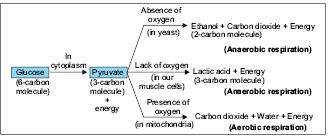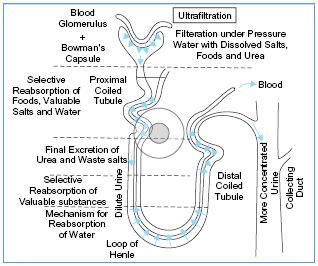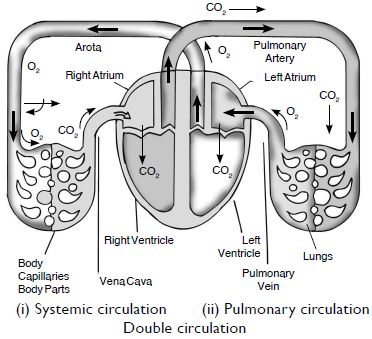Question 1:
Why is diffusion insufficient to meet the energy requirements of multicellular organisms like humans?
Answer:
In multicellular organisms, all the cells of body may not be in direct contact with the source of oxygen, i.e., the environment. Thus, simple diffusion will not be enough to meet the oxygen requirements of all the cells. These organisms require specialised organs to meet the oxygen requirement of their cells.
Question 2:
What criteria do we use to decide whether something is alive?
Answer:
To decide if, an organism is alive, we look for movement, growth, metabolic activities, cellular body organisation, nutrition, respiration, transportation of substances within the organism’s body, excretion, response to stimuli and reproduction.
Question 3:
What are outside raw materials used for by living organism?
Answer:
(a) Food: It is the source of energy.
(b) Oxygen: It is required for breaking down of carbon based molecules to liberate energy in
the body.
(c) Water: It is required for proper digestion of food and other functions in the body.
Question 4:
What processes would you consider essential for maintaining life?
Answer:
(a) Nutrition
(b) Respiration
(c) Transportation
(d) Excretion
Question 5:
What are the differences between autotrophic and heterotrophic nutrition?
Answer:
The differences between autotrophic and heterotrophic nutrition are:
Question 6:
Where do the plants get each of raw materials required for photosynthesis?
Answer:
Raw materials of photosynthesis are CO2 and water. The energy required is supplied by the sunlight. CO2 is obtained from air. It enters leaves through stomatal openings. Water is obtained from the soil. It enters leaves through the mid-rib and veins. The water is absorbed by the roots from the soil.
Question 7:
What is the role of acid in our stomach?
Answer:
(a) It provides the acidic medium which is required for the action of enzymes. It changes
the pH of food.
(b) It activates the proenzyme ‘propepsin’ into active pepsin.
(c) It destroys the bacteria present in food.
Question 8:
What is the function of digestive enzymes?
Answer:
Digestive enzymes convert the non-diffusible form of food into diffusible form.
(a) Ptyalin converts starch (complex carbohydrates) into maltose.
(b) Pepsin breaks down proteins into peptides and amino acids.
(c) Lipase acts on fats and forms fatty acid and glycerol.
(d) Maltase acts on maltose and forms glucose.
Question 9:
How is small intestine designed to absorb digested food?
Answer:
Small intestine is a long tubular structure. The inner wall of the small intestine has large number of finger like projections called villi. They increase the surface area for absorption of food.
Question 10:
What advantage over an aquatic organism does a terrestrial organism have with regard to obtaining oxygen for respiration?
Answer:
The amount of oxygen dissolved in water is very low as compared to the amount of oxygen in
air.
Thus, terrestrial organisms have to make less effort to obtain oxygen.
Question 11:
What are the different ways in which glucose is oxidised to provide energy in various organisms?
Answer:
Different pathways to provide energy from glucose are depicted in the following chart:

Question 12:
How are oxygen and CO2 transported in human beings?
Answer:
Oxygen is transported from the respiratory organs to body cells with the help of haemoglobin. In the alveoli of the lungs, the haemoglobin (Hb) present in red blood corpuscles combines with the oxygen to form oxyhaemoglobin. When the blood reaches the tissues, oxygen is released from the oxyhaemoglobin for the consumption by the tissues. Some of O2 is transported in the solution form by plasma of blood. Carbon dioxide diffuses into blood plasma to form a physical solution. It forms unstable carbonic acid with water and is transported as such. It is also transported from tissues to lungs as bicarbonates.
Question 13:
How are lungs designed in human beings to maximise the area for exchange of gases?
Answer:
Within the lungs, the primary bronchi divides into smaller and smaller tubes which finally terminate into balloon-like structures called alveoli. These alveoli increase the surface area for exchange of gases. The walls of the alveoli are elastic and are supplied with capillaries. Through these thin walls gases are exchanged between the capillaries and the air sacs.
Question 14:
What are the components of transport system in human beings? What are the functions of these components?
Answer:
There are two main transport systems in human beings—blood vascular system and lymphatic
system.
The components of blood vascular system are:
(a) Blood: It is a reddish, viscous, fluid connective tissue. An adult human being has about
5-6 litres of
blood. Blood consists of Red Blood Corpuscles (RBCs), White Blood Corpuscles (WBCs), blood
platelets and plasma. Blood transports digested food, oxygen, carbon dioxide, nitrogenous
wastes
and hormones in the body.
(b) Heart: It is a hollow, muscular, pumping organ, which pumps the blood in the body. It
has four
chambers, the two receiving chambers called auricles or atria and two distributing chambers
are
called ventricles. The left auricle receives purified blood from the lungs and empties into
the left
ventricle. The left ventricle distributes blood to various organs and tissues through blood
vessels.
The right auricle receives impure blood from all parts of the body and empties it into the
right
ventricle. The later sends blood to the lungs. Heart pumps the blood into the body.
(c) Blood Vessels: There is a network of blood vessels in the body. The blood vessels which
carry
oxygenated blood are called arteries and those carrying deoxygenated blood are called veins.
Components of lymphatic system are lymph, lymph vessels, lymph capillaries and lymph nodes.
Question 15:
Why is it necessary to separate the oxygenated and deoxygenated blood in mammals and birds?
Answer:
In the heart of mammals and birds, separation of blood allows a highly efficient supply of oxygen to the body, which is essential for animals with high energy needs. They also constantly use energy for maintaining their body temperature.
Question 16:
What are the components of transport system in highly organised plants?
Answer:
The components of the transport system in plants are:
(a) Xylem vessels and tracheids of roots, stems and leaves. They are concerned with the
transport of
water and minerals.
(b) Phloem consists of sieve tubes and companion cells. It transports food, amino acid and
other
substances from leaves to various parts of plants.
Question 17:
How are water and minerals transported in plants?
Answer:
Water and minerals are transported in plants by xylem and phloem tissues in the following ways:
Question 18:
How is food transported in plants?
Answer:
(a) The food prepared in the green leaves of plants is transported through phloem in the
form of
sucrose solution to storage organs of roots, stems and fruits. This process is called
translocation.
(b) Translocation occurs in the sieve tubes of phloem with the help of companion cells. It
occurs both
in upward and downward directions.
(c) This process requires energy. It is provided by ATP molecules.
(d) This increases osmotic pressure in the tissue causing water to move into it.
(e) This pressure moves the material in the phloem to tissues which have less pressure.
Question 19:
Describe the structure and functioning of a nephron.
Answer:
A nephron is made up of a globular double walled Bowman’s capsule around a clump of
capillaries or
glomerulus and a tubule surrounded by blood capillaries. The nephron empties into a
collecting duct.
All the collecting ducts discharge into a central cavity of the kidney (pelvis) that
connects to the ureter.
Urine is formed by three processes—glomerular filtration, tubular reabsorption and tubular
secretion
in the nephrons of kidney.
(a) Glomerular filtration or ultrafiltration: Blood is filtered under pressure in the
glomeruli present
in the cup-like structure of Bowman’s capsule.

(b) Tubular reabsorption: In the proximal coiled tubule; glucose, amino acids, vitamins and
hormones,
most of the inorganic ions are reabsorbed by active transport; most of the water by osmosis;
and
some urea by back diffusion from nephric filtrate.
(c) Tubular secretion: In the distal coiled tubule, collecting tubule and collecting duct,
many ions,
water (depending upon availability) are secreted. Urine formed passes into bladder from
kidney
through ureters.
Question 20:
What are the methods used by plants to get rid of excretory products?
Answer:
(a) In plants, excess of water passes out during transpiration.
(b) Plants get rid of dead tissues as a measure to eliminate waste.
(c) Waste products are also stored in cellular vacuoles.
(d) Waste products are eliminated with falling leaves.
(e) Resins and gums are waste materials that are stored in the old xylem.
(f) Plants also excrete wastes into soil through roots.
(g) Aquatic plants lose their waste products by diffusion into the water.
Question 21:
How is the amount of urine produced regulated?
Answer:
Urine volume concentration is regulated by the same process as the blood volume. Antidiuretic hormone (ADH) is produced by posterior pituitary gland which increases the quantity of water reabsorbed in the distal convoluted tubule and collecting duct. In the hypothalamus, osmoreceptors signal the posterior pituitary gland to increase ADH secretion when plasma osmolarity becomes too high. ADH causes decreased urine volume and decreased osmolarity. Thus amount of urine produced is regulated.
Question 22:
The kidneys in human beings are a part of the system for:
- Nutrition
- Respiration
- Excretion
- Transportation
Answer:
(c). Excretion
Question 23:
The xylem in plants is responsible for:
- Transport of water
- Transport of food
- Transport of amino acids
- Transport of oxygen
Answer:
(a). Transport of water
Question 24:
The autotrophic mode of nutrition requires:
- Carbon dioxide and water
- Chlorophyll
- Sunlight
- All of these
Answer:
(d). All of these
Question 25:
The breakdown of pyruvate to give carbon dioxide, water and energy takes place in:
- Cytoplasm
- Mitochondria
- Chloroplast
- Nucleus
Answer:
(b). Mitochondria
Question 26:
How are fats digested in our bodies? Where does this process take place?
Answer:
Digestion of fats is started in the stomach and completed in small intestine. Gastric juice of stomach has a weak lipase enzyme which hydrolyses only small amount of fats. Pancreatic juice contains strongest lipase enzyme which hydrolyses about two-third of the fats while digestion of fats is completed by intestinal lipase enzyme. Digestive products of fats are fatty acids and glycerol.
Question 27:
What is the role of saliva in the digestion of food?
Answer:
Saliva of salivary glands of human contains a carbohydrate-digesting enzyme called salivary amylase (or ptyalin). It hydrolyses about 30–40% of starch of ingested food into maltose and isomaltose at pH 6.8.
Question 28:
What are necessary conditions of autotrophic nutrition and what are its by–products?
Answer:
Necessary conditions for autotrophic requirements are simple raw materials, carbon dioxide and water. To carry the process of photosynthesis, a green pigment chlorophyll and sunlight are also required. By–products of photosynthesis is oxygen, which is released due to photolysis of water in this process.
Question 29:
What are the differences between aerobic and anaerobic respiration? Name some organisms that use anaerobic mode of respiration.
Answer:
Question 30:
How are the alveoli designed to maximize the exchange of gases?
Answer:
To facilitate exchange of gases, the alveoli are thin walled (lined by an endothelium of flat cells), moist (by mucus of goblet cells), vascular (supplied by pulmonary capillaries), permeable and numerous in number (about 700 million) to provide large surface area.
Question 31:
What would be consequences of a deficiency of haemoglobin in our bodies?
Answer:
Deficiency of haemoglobin decreases oxygen carrying capacity of RBCs from the lungs to the body tissues which causes hypoxia in the body tissues. This decreases the energy supply and metabolic rate of the organism.
Question 32:
Describe double circulation in human beings. Why is it necessary?
Answer:
Human heart is four-chambered and shows double circulation of blood. It involves two
circulations:
(i) Pulmonary circulation is completed
from right ventricle to left auricle
via the lungs. Right ventricle pumps
deoxygenated blood to the lungs
through pulmonary arch and
pulmonary arteries, while oxygenated
blood from the lungs to left auricle is
carried by pulmonary veins.
(ii) Systemic circulation is completed
from left ventricle to right auricle via
all other body organs except the lungs.
Left ventricle pushes oxygenated
blood into systemic aorta which
supplies it to the body parts through
arteries. The deoxygenated blood is
carried to right auricle by great veins.
Necessity of double circulation: Such
a type of circulation of blood ensures
a highly efficient supply of oxygen to the body, because it avoids mixing of the oxygenated
and
deoxygenated blood.

Question 33:
What are the differences between the transport of materials in xylem and phloem.
Answer:
Through xylem moves water and minerals obtained from soil. On the other hand phloem transports products of photosynthesis from the leaves, where they are synthesised, to other parts of plant. Besides products of photosynthesis, phloem also transports amino acids and other substances. For efficient transport of water, factors like transpiration pull and cohesive force of water are responsible. The translocation of food in phloem is achieved by utilising energy. With ATP, food is transferred to phloem. Due to this increase in osmotic pressure, water moves into it. This moves the material into tissues having less pressure.
Question 34:
Compare the functions of alveoli in the lungs and nephrons in the kidneys with respect to their structure and functioning.
Answer:
- Alveoli are sites of respiration inside the lungs while nephrons are structural and functional units of excretion of the kidneys.
- Alveoli are thin-walled sacculated structures while Bowman’s capsules are cup-like structures of the nephrons.
- Alveoli allow exchange of oxygen of air and carbon dioxide of blood (i.e., gases only) while glomerulus allows the passage of water and a number of water soluble microbiomolecules (i.e., liquids only).
- Selective reabsorption occurs in the nephrons while it does not occur in the alveoli.



